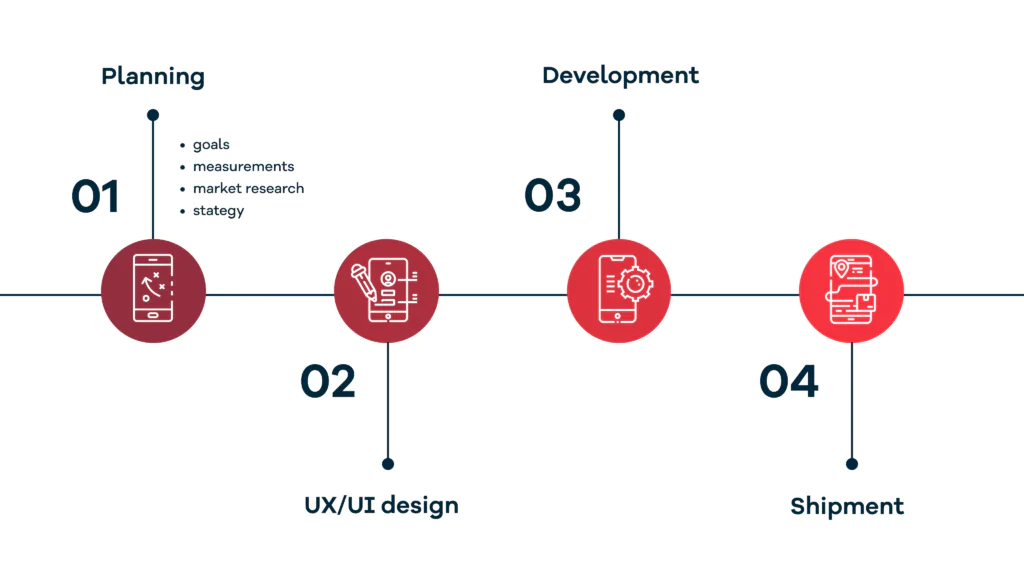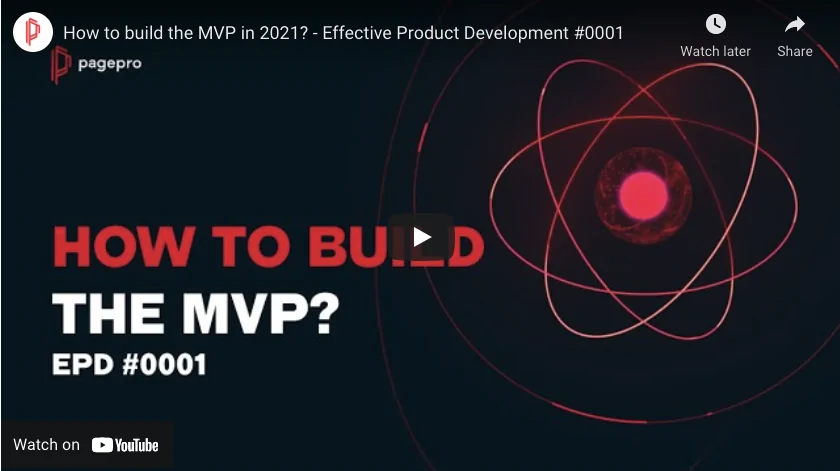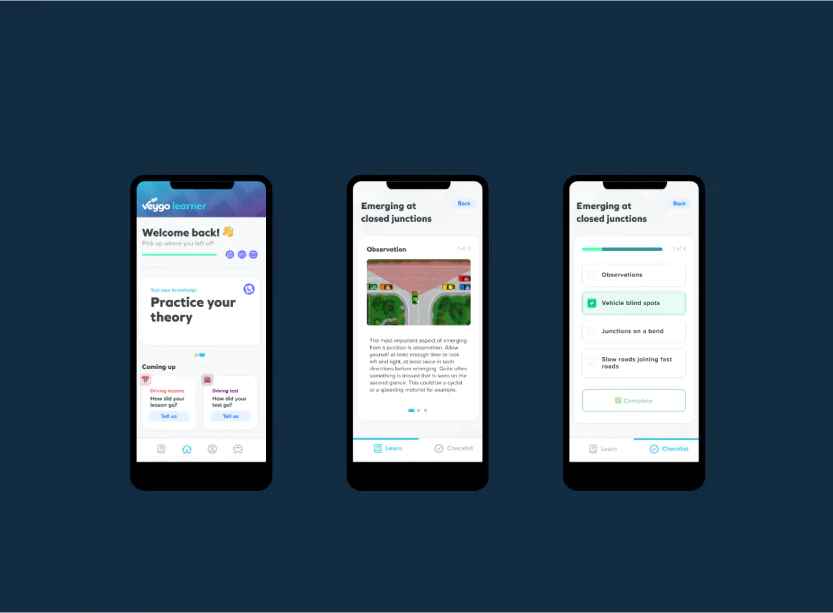How To Build a Project Plan For Mobile App Development

Intro
Smartphones are an inseparable element of our life. In a world where mobile apps are expected to generate over $935 billion in revenue by 2023, looking for a way to build a project plan for mobile app development is a good starting point on your way to success.

Some can say that mobile apps rule the world. And statistics don’t lie – apps have the power. As of 2021, Google Play has over 3,482,452 available apps and an Apple App Store of about 2,226,823. Even though this information may be overwhelming, as the number of potential competitors is vast, it shows how high the demand for mobile apps is.
Seeing stats like this, it’s not surprising that you think about a mobile app as a great addition to your business plan, and you are looking for a custom mobile app development company that will make your dream come true.
But are you ready for this? Did you think about everything? As both the potential and competition are massive, a good app development project plan is essential to success.
In general, the mobile app development process consists of a few stages:
- Planning
- UX/UI design
- Development
- Shipment

We’ve prepared this quick guide to show you how to build a project plan for mobile application development and to help you understand what to expect and how to get yourself prepared for this procedure.
Define your product
The first phase of the mobile app project plan would be defining the product. App development without a clear purpose will probably be a waste of time and money.
Below you can find questions that will help you to go through this step.
What is the app’s purpose?
Look at this question from two perspectives.
The first one is defining your goals as a business:
- What challenges does your mobile app address?
- What do you want to achieve with the app?
- Do you want to increase brand awareness, get new leads, sell, educate or entertain your customers?
The purpose doesn’t have to be complicated – the easier, the better.
If it’s longer than two sentences, it means that it’s too confusing even for you and not targeted enough.
I’m sure you’ve heard about Candy Crush – one of the most popular gaming apps, which revenue in 2020 was $1190 mln. The purpose of the app was simple: to entertain.
How will you help/entertain/serve users?
On the other side, there are your customer’s needs.
Put yourself in your customer’s shoes and wonder:
- How will your mobile app improve their life?
- What problems will it solve?
- Why would they want to use it?
- How will it make their life easier, better, or more fun?
Remember that there’s a huge competition out there, so people would need a reason to choose your app over others.
Want to build cross-platform mobile apps?
What will be the main feature(s) of the application?
While considering the idea of the mobile app, a good starting point is preparing two sets of features: ‘must-have’ and ‘nice-to-have’.
Further on, during customers and competitors analysis, you will be able to add/delete some of them.
Based on the ‘must-have’ features, you can build the MVP to check out if there is any interest in your product without too much investment.
With the MVP, you appear on the market with the core functionality and get feedback from the real customers.
Once you know that it’s worth further development, you can add all the features that it’s ‘nice-to-have’, which will make your app more user-friendly.
If you want to know more about building the MVP, check out our video.

How will you measure the success?
Setting the mobile app KPIs and choosing the right tools to measure them is an essential step on your way to success.
Even though collecting and evaluating data starts after the final stage of the development process, many decisions you would make during the next steps will be based on the expectations you are setting right now.
The most popular (and worth considering) KPIs for the mobile apps are:

- Load speed – in such a competitive environment as the mobile app’s world is, load time is one of the most important factors for your user. Mobile users don’t like to wait. For anything. So if the load times are long on your app, you can be sure they will abandon it – sooner or later.
- Daily and monthly active users – active users, are those who launch the app and actively use it. This number should grow month by month, and if you can see the drop, you should take some marketing actions to take it for the right track.
- Churn rate – it shows how many users decided to abandon your app after using it a few times. This number should stay low. If you see that many people uninstall your app, you can consider:
- Checking out if there are any bugs
- Adding some updates or new content
Market research
Once you know what you want to achieve and deliver, you can start to gather information about the market and your target group.
Remember that the possibility that your app will have no competitors is nearly 0.
That means you will have to provide something new or in a different way to stand out, but you also have additional sources of knowledge about the market.
Target group
Understanding the target group is the key, and that means both what they’re like, and what are their pains and needs. Considering this at the planning stage is important because it influences the product’s UX/UI design and monetisation.
We can assume that you have already decided what will be the main features of your app. By analysing the product and benefits it provides, make a list of people who have a need that your benefit fulfils. Remember to check out who is using similar apps, what other apps they use and what mobile devices do they use.
The next thing is identifying your target audience’s demographic. The main factors are age, location, gender, income level, education level, marital or family status, occupation.
We’ve prepared a list of questions that will help you recognise your target customers.
On the right side of the table, you can find sample answers for a potential customer of an app with yoga exercises.
| What do you want your customers to do? | Buy access to premium features |
| Will they be limited to any demographic profile? | Women, 20-40 years old, employed, married or single |
| Are you planning to have any localization limits? | Living in the UK |
| What needs and challenges do they have? | They want to get access to professional yoga teachers and have the possibility to choose the right training; they want to learn yoga at home |
| How does your mobile app help them face these challenges? | We provide different types of training with the possibility to buy a one-to-one session with the chosen teacher |
| What drives them to make a purchase? | Sample lessons showing the possibilities of the app; positive reviews |
| Are they using similar apps? | Yes; Down Dog, Daily Yoga, Asana Rebel |
| How would you reach the audience? | Ads on Social Media, ads in app stores, create a website |
Listen to your potential customers
Once you define the target audience take a look back at your features – should you add anything? Check out the reviews under the apps from the same industry.
People who leave them usually share in-depth reviews, which may show you what they like and, even more important – what they don’t like.
If people are pointing up one of the issues that drive them crazy – don’t add it.
By listening to your potential customers, you can avoid some of the negative comments under your app.
During this step, significant changes can happen to the app concept based on the customer’s needs.
Competitors research
Your competitors are apps that:
- fit your app’s niche,
- target a similar audience,
- have similar features and are shown under similar keywords.
Make sure you understand how they work, what problems they solve, and think about how they can be improved by you.
Once you establish your main competitors, check their online presence. It’s important to realize how they reach customers if they have a website and what marketing activities they do.
Once it’s done, it’s time to wonder:
- How your idea would differ from the competition?
- Which values would you provide?
- And why would customers choose your product over the others?
After a deep competitor analysis, you can update the definition of your product in your mobile app development plan to make it unique and high-value.
Many tools available to the market can help you with the research at this stage and further along your journey, like:
Further strategy
So you’ve defined the market and your app – you’re ready to make the other decisions.
Choosing the ideal platform for your mobile app
In many cases, it’s a platform that determines how successful the project is.
While choosing the platform, you have to consider some important factors.

Features and platforms
Compare the features you want to develop with the capabilities of a particular platform.
I.e. for a custom app with the native look and feel, WP, iOS, and Android are the best, but for a more all-inclusive app, cross-platform app development will be a better choice. On the other hand, some features that come with the easy implementation for native ways might not receive support for cross-platform solutions.
User expectations
Once you know the target market, you know a little bit about what they like and need and what mobile devices they use.
Expectations are different for each mobile app development platform. Usually, apple users are keener to invest in in-app purchases, as they are loyal to the brand. Still, at the same time, they expect extreme usability and trendy design from the applications they utilize. Android users are more understanding of shortcomings but less keen on paying for apps.
Target audience
After researching and creating the customer profile, you know who will possibly use your app.
When choosing the platform based on the target market, the geographic criteria are vital. Most Europeans use Android, Americans do both, but in Asia, it depends on the country. Once you know where your target persona is, you can find out what platform he will possibly use.
Development cost
The price of the app development will vary depending on the platform you choose and the complexity of the process.
Choosing React Native to build your app can help you to cut costs, especially if you want to deploy apps on Android and IOS.
If you still don’t know which platform will be the best for you, contact us. Our experts are ready to answer all your questions.
Setting the timeframe for the project
Mobile app development doesn’t happen overnight, but it’s worth spending all this time on development to make the app as good as it could be.
On average, building an app takes 3-9 months. You can tentatively schedule the date for the release and then verify it with the developer.
If the agency is experienced enough, they should be able to give a somewhat precise estimation. However, if the project is more complex, it’s super hard to estimate the delivery time even for the most experienced teams.
We always do our best to fit it into the customer schedule. One of the interesting projects we provided in a limited time was an MVP that aimed to validate a new business idea.
The customer asked a simple question: Guys, if you got 4-6 weeks, what’s doable?
After choosing the main features and requirements, we decided to create a cross-platform app with React Native.
We fitted into the schedule and provide high-quality MVP that helped the customer to recognize the potential and decide to move into further development.

Choosing the right partner
Once you know which platform will work for your success, you need to find the right partner.
The primary question you have to answer is whether you want to work with an in-house development team, a dedicated agency, or freelancers.
It often depends on the size of your company and the budget you have for the development.
It’s always worth checking the portfolio of the potential partner to see what projects they’ve done in the past. In the ideal world, they will show you similar projects to your app idea.
Reading reviews and testimonials are part of this process. Clutch is one of the independent portals where you can verify what agencies said about themselves.
If you decide to work with react native developers, read more about choosing the right partner here.
We’ve prepared the checklist to help you prepare an app development project plan
Wrap up
Mobile app development is an ongoing process and even after appearing on the market, your product may need some work, especially after the first reviews.
Planning is a fundamental step on your way to the perfect app. It can significantly decrease the number of bugs and reduce the time of the whole process.
FAQ
What factors should influence the choice of platform for my mobile app?
Choose a platform based on your app’s features, target audience’s preferences, expected user expectations, geographic distribution, and development cost. This decision can significantly impact your app’s success. But remember that if you want to reach both Apple and Android users, choosing cross-platform mobile development can be the best and most cost-effective solution.
How long does it typically take to develop a mobile app?
The development timeframe can vary widely but usually ranges from 3 to 9 months, depending on the app’s complexity and the development team’s experience.
What criteria should I consider when selecting a development partner?
Evaluate potential partners based on their expertise in your desired platform, their portfolio of similar projects, client testimonials, and their capacity to meet your project’s schedule and budget.
Build your app with top mobile developers
Read more
Benefits of using react native for mobile app development




comments
Jack S Winslow
Posted on
love this article
Comments are closed.